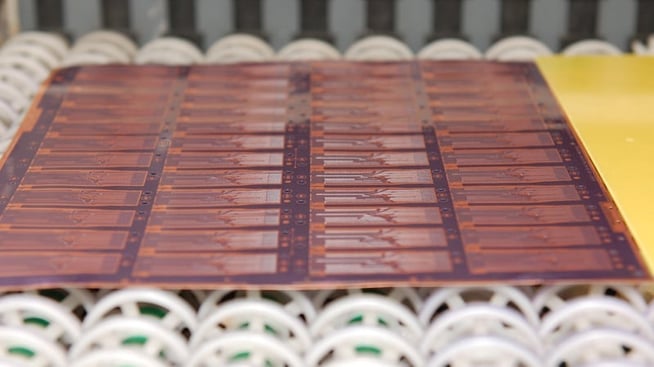Today, there are well over 3,000 companies that manufacturer printed circuit boards (PCB) in Asia (China, Taiwan, Japan, India, Korea, Thailand) with the supply capacity continuing to grow well ahead of the global demand.
This means that many of these manufacturing shops are looking for ways to do things that others can’t do in order to grow their business (As a side note, many of these shops are choosing just to lower prices in order to compete but as costs continue to rise in Asia, this strategy has not been very successful). One of the things that some of these shops try to do is expand their services by providing flex and rigid-flex circuits to their customers.
This makes sense to them because “technically”, you use all of the same equipment to make a flex/rigid-flex board that you do to make a traditional rigid PCB. Most of these factories quickly find out that the manufacturing process, equipment, and expertise to be successful at manufacturing flex/rigid-flex parts are much different than they are used to.
The following is a list of technical challenges that every customer should ask their flex or rigid-flex PCB manufacturer in China or other parts of Asia.
1. Do they manufacture their own flex circuits?
In my 15 years of experience in working with PCB manufacturers in Asia, a good 75% of companies that say that they make rigid flex PCBs outsource the flexible circuit board part of the process. While outsourcing as a concept is not a bad thing, when you outsource one of the most critical components of the end product, it always causes challenges.
Start with delivery; these manufacturers are outsourcing this product to a competitor whose ultimate goal is to service their OEM accounts first. So, if their biggest account drops a huge order on them, they will finish those parts before they get parts for a competitor.
Along with the delivery is quality. The IPC standards for flex PCBs are much different than those for rigid PCBs. So, do they have an IPC certified inspector for flex circuits at their facility?
2. Do they have equipment Specifically For manufacturing flex circuit boards?
As I mentioned above, one can use the same equipment to manufacture flex circuit boards as is used to manufacture rigid printed circuit boards. However, the level of quality and the ability to control processes is very different.
A few examples:
Etching Equipment – In the old days the saying was “an etcher, is an etcher, is an etcher”, and you could just create work around to use the one piece of equipment for any type of project. With today’s designs, that is just not true.
Dedicated develop-etch-strip lines for flex circuits is a must as thin core flexible materials must be processed on specialized equipment with certain types of rollers along with different chemistries that allow companies to process very tight line and space widths on these circuits.

Flexible PCB During the Etch Process
When trying to process thin core flexible circuit boards on equipment that is designed for rigid PCBs, we have seen panels get wrapped up around rollers, unevenly etched as the panel flexes when the chemistry is sprayed during the process, and in the worst instance, panels fall between the rollers and into equipment which requires the machine to be shut down for repairs.
Coverlay Lamination – When you attach a coverlay to just a flex circuit, it must be done under pressure and at a certain temperature. When manufacturing rigid printed circuit boards, we use multi cavity lamination press to press layers together when producing multilayer(s). While this equipment can be used for coverlay lamination, it is not ideal as it takes too long and is harder to control for this process.
With the invention of a Quickpress, companies can quickly and accurately adhere to the coverlay to the substrate. Quickpresses only press one or two panels at a time so it is easier to control temperature and because of how quickly this process is, which dramatically helps reduce the customer lead time.
Laser Drills/Routers – Typically laser drills are used to drill mirco vias in very high technology printed circuit boards. But what they are also used for is control depth routing and routing of internal patterns on rigid flex circuits as well. When you have a complex design where the flexible PCB that connects the rigid sections is non-conventional shape, we must laminate the flex and rigid sections as complete panels. Then at the end of the process we use a laser cutter to rout away the unwanted material down to the final designs.
This is often very difficult to do with conventional mechanical routing process as the clearances are usually very minimal.
3. Do they have the in-house engineering and production experience to Ensure their Designs Are Both manufacturable and reliable?
Rigid-flex printed circuit boards behave much differently in production and in the final application than rigid printed circuits boards. Delamination at the point where the flex and rigid parts come together are quite common in these designs.
Understanding clearances of the bend radius, the use of Eccobond (where appropriate), the best stiffener material, and other technical details are critically important in assuring that the design is robust.
Summary
There is a lot of science that goes into the manufacturing of flex and rigid-flex printed circuit boards and there are companies out there with significant experience in making sure that you get great parts quickly. Unfortunately, there are also companies that are just trying to book business which can make the reliability of your product suspect in the long term.
Key Takeaways
- Many Asian PCB Shops Lack True Flex Expertise: While over 3,000 PCB manufacturers operate in Asia, most lack the specialized equipment and experience needed to produce reliable flex and rigid-flex circuits, often outsourcing critical steps to competitors.
- Outsourcing Creates Delivery and Quality Risks: When a manufacturer outsources the flex portion of a rigid-flex design, delays and quality issues can occur since the supplier prioritizes their own OEM customers and may not meet IPC flex standards.
- Flex Circuits Require Specialized Equipment: Processes like etching, coverlay lamination, and laser routing demand dedicated tools such as Quickpress systems and flex-specific etch lines to handle thin cores and tight tolerances safely.
- Engineering Knowledge Is Crucial for Reliability: Flex and rigid-flex PCBs behave differently than rigid boards, requiring careful attention to bend radius, stiffener material, adhesives, and delamination risks to ensure long-term performance.
- Partner Selection Determines Success: Choosing a PCB manufacturer with in-house flex capabilities, dedicated equipment, and proven engineering expertise ensures high-quality, reliable parts and avoids costly manufacturing setbacks.
















